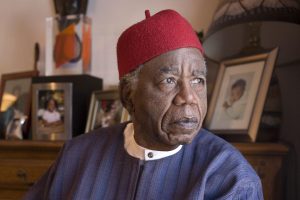Renowned modern African writer Nuruddin Farah is well-known for his thorough investigation of Somali society, culture, and identity. Farah, who was born in Baidoa, Somalia, in 1945, has spent decades developing himself as a potent storyteller and perceptive observer of the subtleties of Somali society. Mostly written in English, his writings explore issues of political tyranny, gender relations, and the effects of civil war on personal and group identity. Rich in cultural complexity, Farah’s stories provide readers with a thorough awareness of the Somali experience—in the diaspora as well as the motherland.
Literary Journey and Themes
Farah started his writing career in the late 1960s, and his works have often mirrored the turbulent past of Somalia. Emphasizing the hardships of women in Somali culture, his early books, like From a Crooked Rib (1970), addressed questions of gender and social justice. With its honest depiction of female tyranny and resiliency, this book—which chronicles a young lady escaping an arranged marriage—was revolutionary.
Farah has stayed dedicated across his career to investigating the junction of political and personal life. Examining the displacement and fragmentation experienced by Somali people resulting from civil war and tyranny, his work is often imbued with a feeling of exile—physical and emotional. Farah himself has lived in exile for much of his life; this fact profoundly shapes his viewpoint and narrative.

Best Work: Maps
Among Nuruddin Farah’s many highly praised creations, Maps (1986) is most often seen as his masterpiece. The book is the first in his Blood in the Sun trilogy, which also comprises Gifts (1993) and Secrets (1998). Through the eyes of a young Somali lad called Askar, Maps is a sophisticated and creative story that examines ideas of identity, memory, and belonging.
Plot Overview
Maps is set against the late 1970s Ogaden War between Somalia and Ethiopia. The book centers on Askar, an orphan brought in and reared by a lady called Misra in a tiny Somali town. Born Ethiopian, Misra becomes Askar’s mother figure; nevertheless, her identification as an outsider in Somali culture strains and questions their bond.
Growing up, Askar struggles with issues of allegiance and identity especially when the battle between Somalia and Ethiopia becomes more intense. The book is set in a non-linear sequence with time and viewpoint changes reflecting Askar’s fractured view of his own identity. Using maps as a metaphor throughout the book, Farah emphasizes the ideas of boundaries, belonging, and the search for self-definition in a society beset by political and social change.
Themes and Literary Style
Maps is famous for its sophisticated narrative framework and examination of difficult ideas of identity and nationhood. Farah explores the flux of identity in a society where borders—both real and symbolic—are always changing with Askar as her guide. As Askar tries to balance his love for Misra with the increasing nationalist attitudes that call her an alien, the book explores the psychological effects of conflict and exile.
The book looks at how memory shapes identity as well. Askar’s fractured and unreliable memories of his past mirror the unsettling consequences of living in a society ripped apart by strife. Maps’ poetic language, sophisticated characterizing, and use of many narrative voices define Farah’s literary approach. Maps is a very engrossing and provocative book as this artistic method lets readers feel the uncertainty and ambiguity defining Askar’s universe.
Contribution to African Literature
Unmatched in contribution to African literature, especially in providing voice for the Somali experience, is Nuruddin Farah. By means of Maps and his other writings, Farah has exposed the complex interactions between personal identity and national history, therefore providing readers with a sophisticated knowledge of the effects of colonialism, tyranny, and civil war on Somali society.
Farah’s examination of subjects like exile, displacement, and the desire for belonging appeals not just to Somali readers but also to a readership worldwide. He is a major player in the canon of global literature as his work celebrates its capacity to cross geographical and cultural barriers. Farah’s books provide a vital window into the personal cost of political unrest, and his sympathetic treatment of his characters guarantees that their tales will always be current and potent.
Legacy and Relevance Today
Today, Nuruddin Farah’s writings remain pertinent especially as problems of migration, identity, and political unrest are top concerns in many countries. Maps and his other books push readers to contemplate the ways in which larger social and political factors create personal and community identities as well as a reminder of the ongoing influence of history on human life.
Farah’s writing provides young readers with a view into the complexity of Somali society and the difficulties people experience during crises. Anyone interested in delving into the human aspects of conflict and identity should definitely read his books as his work promotes empathy and understanding.
Finally, Nuruddin Farah’s Maps are evidence of both his writing ability and his dedication to delving into the nuances of Somali life. By means of this book, Farah urges readers to go on a road of self-discovery and introspection, negotiating the hazy boundaries between identity, memory, and belonging in a society undergoing continuous transformation.
Please read all our stories on African Literature here




